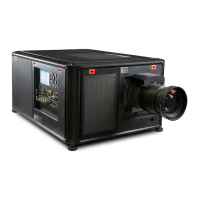R5911443 /11 UDM76
Image 7–20 Exampe of the Tilted brightness uniformity
2. Enable the Tilted brightness correction slider to activate this feature (blue is enabled, grey is disabled).
3. Use the Test Pattern button on the RCU to enable a specific test pattern. While enabled, this will project
the full white test pattern.
Tip: While you can perform the uniformity correction on any projected image, you will achieve the
best result while projecting the full white test pattern.
4. Use a light meter to measure the brightness on the left side, center and right side of the projected surface.
5. Adjust the brightness on the Horizontal axis until the left and right side of the projected surface are equally
bright.
6. Use a light meter to measure the brightness on the top side, center and bottom side of the projected
surface.
7. Adjust the brightness on the Vertical axis until the top and bottom side of the projected surface are equally
bright.
8. Repeat the previous steps until the brightness is even across all sides of the projected surface.
If you feel like you totally messed up with this action and want to start over, press the Reset button.
7.8 Digital shift & zoom
What can be done?
The image can be optically shifted by using the vertical and horizontal lens shift.
If you want to reach a lens shift beyond what is possible with the optical shift, you can also perform a digital
lens shift. This digital shift will occur on the DMD, rather than the lens holder. So take into account that this
additional shift is minimal and restricted to the limits of the chip used.
For the optical zoom and lens shift, navigate to Home → Installation → Lens.
Lens shift is only possible when the used lens has been fully calibrated. To calibrate the current lens,
navigate to System Settings → Maintenance → Lens Calibration.
The effect of digital zoom
This function zooms in the picture digitally. When zooming in, the center of the image will increase in size. This
means that the outer part of the picture will be outside the picture frame. When zooming out, the result is that
the picture will be smaller than the projectors picture frame. The area outside the rendered picture will then be
black.
For an example, see the following photos. The red lines in the figures represent the DMD outline.
GUI – Image

